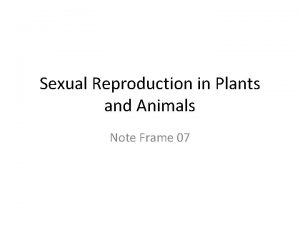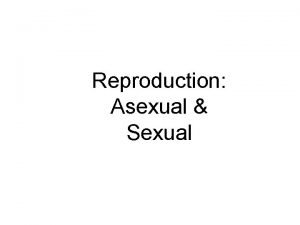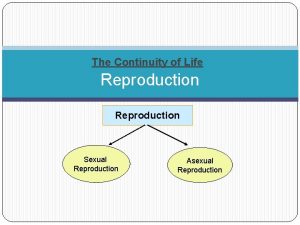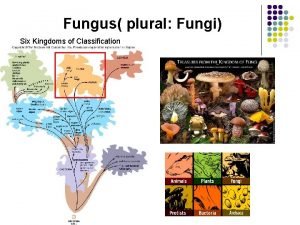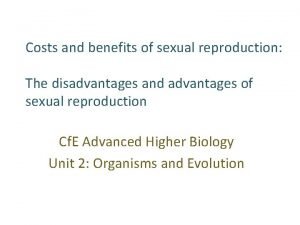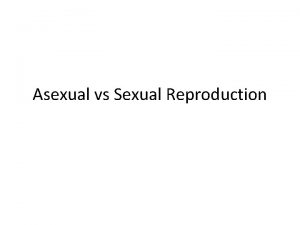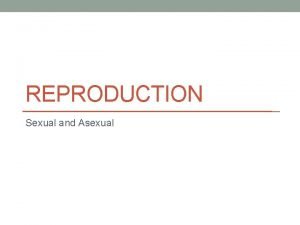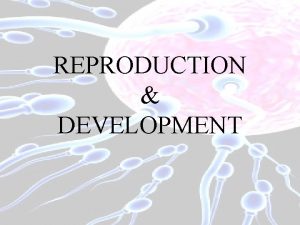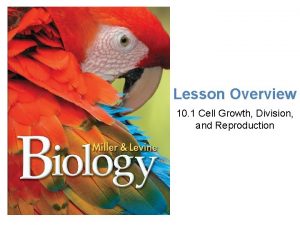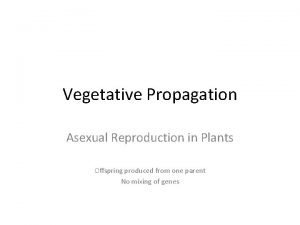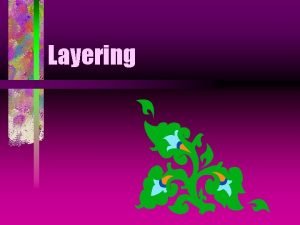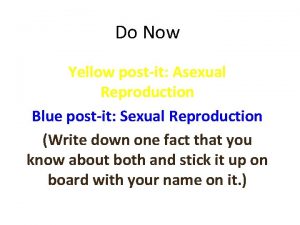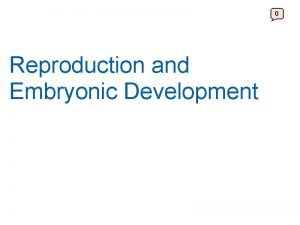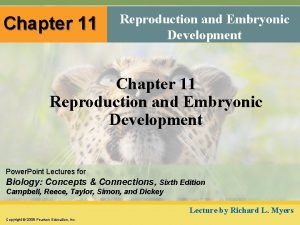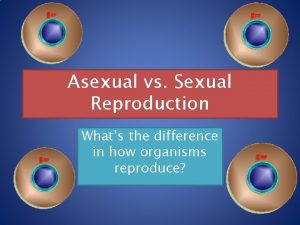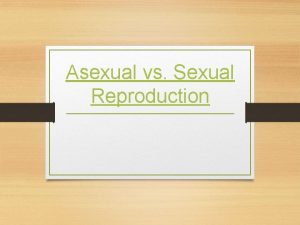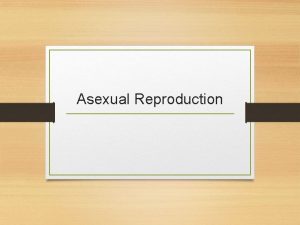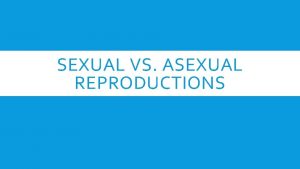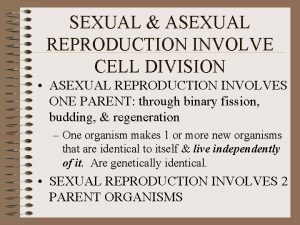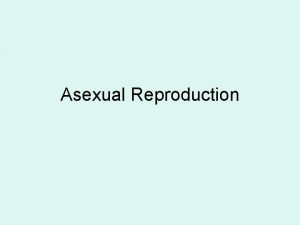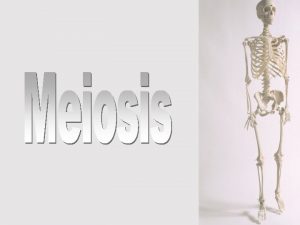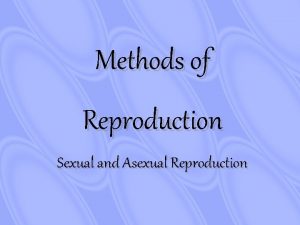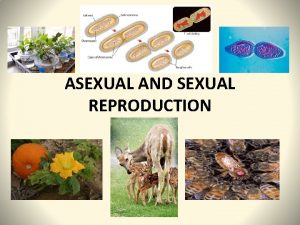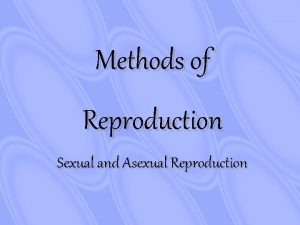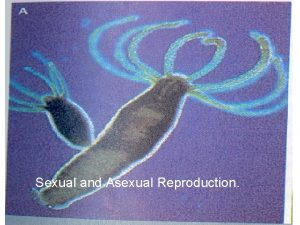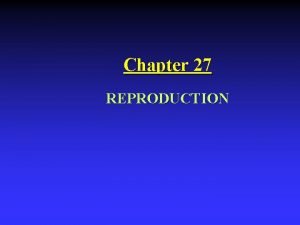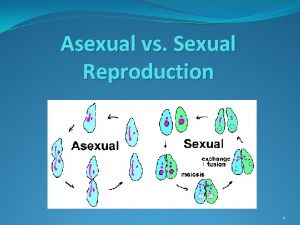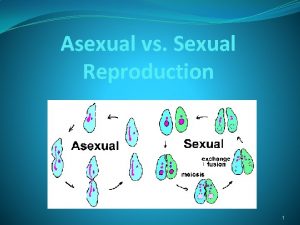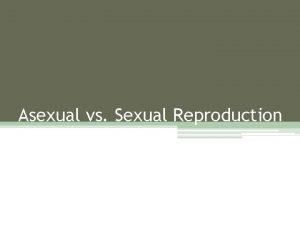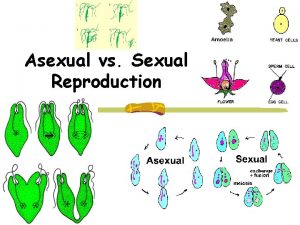Cell Division sexual and asexual reproduction Sexual vs



























- Slides: 27

Cell Division: sexual and asexual reproduction

Sexual vs. Asexual • Sexual reproduction – Occurs in eukaryotes (multicellular organisms) • Asexual reproduction – MOSTLY occurs in prokaryotes (unicellular) – FEW multicellular organisms use asexual reproduction

Asexual Reproduction

Asexual Reproduction • One organism produces one or more new organisms that are identical to itself and that live independently of it • Three types – Binary fission – Budding – Regeneration

1. Binary fission • Form of asexual reproduction • Occurs in prokaryotes (bacteria) • Parent organism splits into two genetically identical cells

2. Budding • Occurs in eukaryotes and prokaryotes • A bud forms from the parent’s cell. The bud grows until it forms a complete new organism with the same genetic material

3. Regeneration • Some animals, when cut in pieces will grow into many animals.

Sexual Reproduction • Production of offspring from two parents. • Sperm + Egg = Zygote • 23 + 23 = 46 • Haploid + haploid = diploid

Sexual reproduction • Plants growing from seeds and animals growing from eggs are examples of organisms that reproduce through sexual reproduction

Categorize Type Cell reproduction Type

Compare and Contrast • Comparing and contrasting sexual and asexual reproduction – Venn diagram – Double bubble – Comparison chart – USE PAGES 88 -92 in Cells and Heredity

2. Spores • Molds & fungi form a copy of the DNA and a protective wall around it. • Billions are released; not all survive.

4. Vegetative Propogation • When plants send out “runners” to look for light.

Meiosis • The production of gametes. • Each new cell has ½ the chromosomes of the parent cell. • Parent cell = diploid (2 n) ex. 46 chromosomes • Gamete = haploid (n) ex. 23 chromosomes

Prophase I • Chromatin coils to chromosomes. • Homologous chromosomes (a pair of chromosomes, each having genes for the same trait) – pair up. • Crossing over – homologous chromosomes exchange genes, increasing genetic variety.

Metaphase I • Homologous chromosomes line up on the equator of the cell.

Anaphase I • Homologous chromosomes are separated.

Telophase I & Prophase II • Cell divides into 2 cells • Each cell has ½ the chromosomes. • Identical sister chromatids are still together

Metaphase II • Sister chromatids line up on the equator of each cell.

Anaphase II • Sister chromatids are separated in each cell.

Telophase II • Each cell divides into 2 new cells. • 4 sperm or eggs have been created, each having ½ the original amount of DNA.

Differences • Sperm – 4 sperms are made from each parent cell. • Egg – 1 egg is formed, the 3 other cells die. • www. classzone. com

Sex Determination • Autosomes – 22 pairs in humans; code for body parts. • Sex chromosomes – 1 pair; code for sex • XX = female • XY = male • Karyotype – a picture of the chromosomes

Sex Determination • Which sperm gets to the egg first determines the sex. • Some sperms have X sex chromosome; some sperms have Y sex chromosome. • Female always gives an X.

Nondisjunction • When the chromosomes do not separate properly during meiosis. • Trisomy - the offspring receive too many chromosomes. • Monosomy – the offspring receive too few chromosomes.

Trisomy • Down’s Syndrome – trisomy 21 – large tongue, short neck, mental retardation • Klinefelter’s Syndrome – XXY – long arms & legs, breasts, hip fat, bad decision maker

Trisomy & Monosomy • XYY Syndrome – higher than usual testosterone • Turner’s Syndrome – X – webbed neck, no puberty, elbow deformity
 Hare lynx
Hare lynx Asexual reproduction cell division
Asexual reproduction cell division Sexual asexual venn diagram
Sexual asexual venn diagram Mitosis sexual reproduction
Mitosis sexual reproduction Difference of sexual and asexual reproduction
Difference of sexual and asexual reproduction Chromosomes in organisms
Chromosomes in organisms Venn diagram sexual and asexual
Venn diagram sexual and asexual Sexual reproduction
Sexual reproduction Where does cactus store water
Where does cactus store water Difference between sexual and asexual reproduction
Difference between sexual and asexual reproduction Example of budding
Example of budding Advantages of genetic diversity
Advantages of genetic diversity Sexual or asexual reproduction
Sexual or asexual reproduction Plural fungus
Plural fungus Sexual or asexual reproduction
Sexual or asexual reproduction Sexual or asexual reproduction
Sexual or asexual reproduction Sexual reproduction
Sexual reproduction Asexual or sexual reproduction
Asexual or sexual reproduction Cell growth division and reproduction
Cell growth division and reproduction Dahlia asexual reproduction
Dahlia asexual reproduction Examples of asexual reproduction
Examples of asexual reproduction Platyhelminthes vs nematoda
Platyhelminthes vs nematoda Asexual propagation layering
Asexual propagation layering Type of sexual reproduction
Type of sexual reproduction Asexual reproduction
Asexual reproduction Asexual reproduction
Asexual reproduction Whats asexual reproduction
Whats asexual reproduction Chapter 19 asexual reproduction
Chapter 19 asexual reproduction








